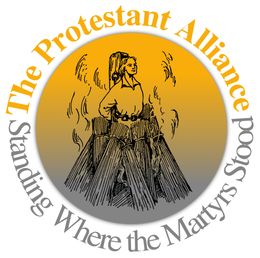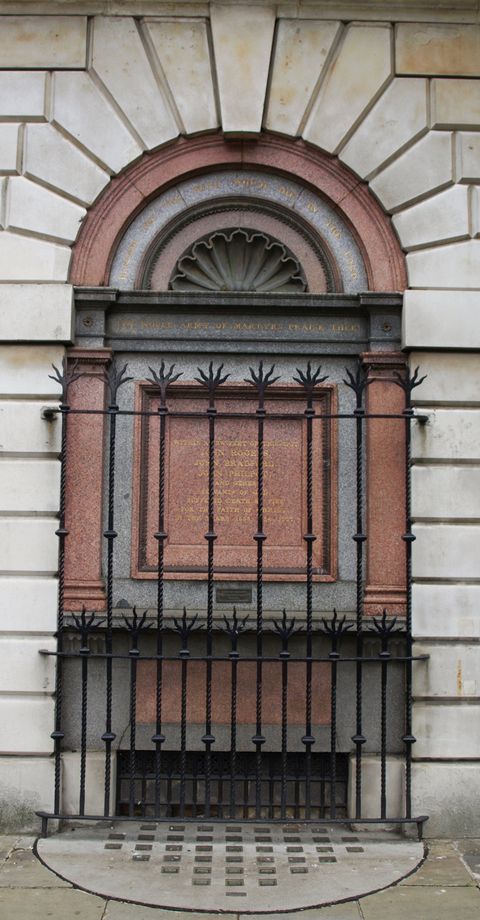
Smithfield

Smithfield Martyrs’ Memorial
The Martyrs’ Memorial at Smithfield was erected by the Protestant Alliance in 1870. The unveiling ceremony took place on Friday 11th March.
A preliminary meeting was held in the Great Hall in St Bartholomew’s Hospital in which Lord Shaftesbury presided. The Chairman of the Alliance stated that “the memorial had not been erected in a spirit of defiance, or to perpetuate the recollection of past wrongs. If those wrongs were not forgotten, it was the fault of the Church of Rome herself. We had received the issues of the martyrs’ deaths in a free Bible, unfettered religious thought and action. The duty of their descendants was to maintain the honour of their blessed names and the integrity of those great principles for which they died.” He went on to tell those present that he “trusted that all who read the inscription on the Memorial would impress upon their children those deeply solemn and mighty principles, those terrible and yet magnificent responsibilities; for it was the glorious attribute of a free agent to have such responsibilities.”
At the unveiling ceremony, in the open air, Lord Shaftesbury addressed what was described as a “distinguished and numerous company” and the memorial was uncovered.
The memorial was designed by the architects Messrs. Habershon and Pite, it was built by Messrs. Cox and Son of Southampton, and is made of red and grey polished granite and bronze. It is remarkable that the memorial survived World War II as within yards of the memorial the wall of St Bartholomew’s Hospital still bears the scars from bomb damage.
Reports of the opening appeared in The Times and other daily London newspapers and an engraving of the memorial appeared in The Illustrated London News. The Times reprinted the entry in 1996, click the small picture to be able to read it.
Location of Smithfield Martyrs' Memorial
1 - Smithfield and its Making
Smithfield, meaning "smoothfield'', was on the very fringe of Roman London. The remains of Roman walls that surrounded the city can still be found in the cellars of certain properties close to Smithfield. King Alfred built a new wall on the Roman foundations to keep out invaders.
Smithfield, just without the city wall, was used in those early times as a water source, the pool at Smithfield being one of the main water supplies for the growing city. On the boggy field animals were grazed and rubbish dumped. Perhaps it was the Augustinian Priory of St. Bartholomew that was built in 1123 that put Smithfield on the map. This Priory included a hospital. A St. Paul's prebendary named Rahere, while on pilgrimage to Rome, was taken seriously ill and while in this state claimed to have had a vision. On his recovery, in obedience to this vision he built the religious house. It rose rapidly and because it included London's first hospital was popular and respected, so much so that at the dissolution of the monasteries, the priory was dissolved but the hospital retained. In 1545 Henry VIII subscribed 500 marks a year for its upkeep. The City authorities also raised a similar sum.
2 - Smithfield and its Market
Rahere instituted an annual fair and market which was held on St. Bartholomew's Day which eventually became a three day gathering being held on 23rd, 24th and 25th August. By the 12th century it was the chief horse and cattle market. In 1614 a regular weekday market began, which of course continues to this day but selling meat rather than livestock.
In the 14th century pigs and other animals freely roamed about in the filthy streets. When the Black Death reached England in 1349, the plague spread rapidly in the unsanitary conditions. About a third of the total population was wiped out. The burden of compulsory labour and taxation was acutely felt by the serfs or peasants. Their Revolt in 1381 led to another chapter in Smithfield's history.
3 - Smithfield and its Mobs
The Peasants' Revolt, led by Wat Tyler, came to an end at Smithfield. The peasants from Kent and Essex had marched on London. Dartford and Canterbury were besieged, Lambeth Palace sacked, and prisoners at Fleet and Newgate released.
Richard II made concessions to the mob. The second meeting between Tyler and the King was at Smithfield. As they met a cry went up. Tyler, fearing a trap, reached for his dagger. However, the Lord Mayor Sir William Walworth had his cutlass drawn and attacked Tyler first. The rebellion thereafter broke up. No redress of the peasants' grievances had been achieved.
In 1450 another mob led by Jack Cade assembled at Smithfield. This second Revolt of 15,000 men from Kent and Sussex met in protest against high taxation and statute of labour, the same causes as the Revolt of 1381. Discontented city dwellers opened the gate of London Bridge to Cade and his followers, but they could not overcome the forces opposed to them and advance further. The Revolt failed. The execution stake was set up and many captured rebels were brought from the Tower to Smithfield for execution.
From here on criminals, rebels and martyrs, all would meet their end at the execution place of Smithfield.
4 - Smithfield and its Martyrs
Statute "De Haeretico Coniburendo'', the "Act for the burning of Heretics'' passed in late 1400 or January 1401 was soon implemented - designed to suppress the Lollards, those godly followers of the teachings of John Wycliffe. The Act soon claimed its first victim, William Sawtrey. He was burnt at Smithfield on 26th February 1401. Just how horrific the martyr fires of Smithfield were is illustrated to us by the martyrdom of John Bradby.
A tailor from Evesham, Bradby was called before the Bishop in 1409 for holding to heretical opinions. On Ist March 1410 he was tried before a Commission in London. Condemned as a persistent and incorrigible heretic he was handed over to the civil authorities for execution. On 5th March at the King's warrant, he was taken to Smithfield, chained in a cask which was set on a pile of wood.
The future King Henry V, then Prince of Wales, was very moved by the plight of Bradby and implored him to save himself by recanting his faith. He would not. A procession of church dignitaries headed by twelve torchbearers and the mass wafer came to the execution. Seeing the host, Bradby exclaimed "It is consecrated bread and not the body of God". The signal was given and the fire started. The martyr felt the flame and cried to heaven, "Mercy!'' The Prince immediately ordered the fire to be extinguished. A second time the Prince promised pardon, favour and even money if Bradby would recant. He remained firm. The fire was rekindled and Bradby met his end bravely, trusting in Christ and Christ alone.
The Reformation martyrs, those martyred in the reign of Henry VIII, added such noble names as John Frith and Ann Askew to the Smithfield Martyr Roll.
The Marian Martyrs also gave many well known names to that same noble army. Unlike the Lollard Martyrs about whom we do not have complete records, the Marian Martyrs are well documented.
Dr. Hansford?Miller gives the number of those burnt at Smithfield during this period (1555?1558) as 45, more than at any other location, the first being John Rogers, Tyndale's associate and the man who gave us the Matthew's Bible.
5 - Smithfield and its Monument
William Harvey, the chief physician at St. Bartholomew's Hospital, proved in 1616 the theory of the circulation of blood. Great as this discovery was for the health and betterment of mankind, the martyrs have left us an even larger legacy, an open Bible, a protestant heritage and liberty, both religious and civil.
Follow Us
©
Copyright 2018 The Protestant Alliance All Rights reserved. Privacy Policy.